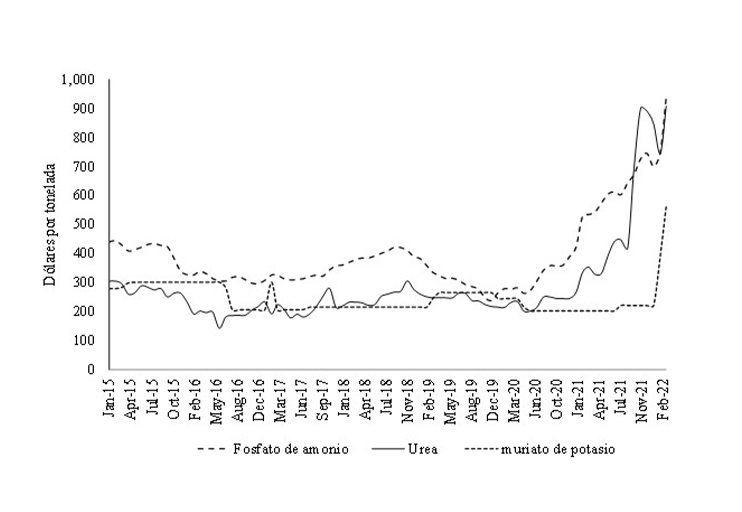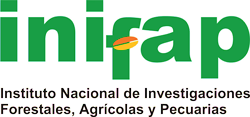Adjustment to optimal-economic fertilization doses when prices change: economic-mathematical analysis
DOI:
https://doi.org/10.29312/remexca.v16i4.3425Keywords:
analysis behind the envelope, fertilization dose, input-output price ratioAbstract
The current situation shows worrying trends that will hinder both food production and the production and use of fertilizers. By 2050, the world population will be 9 200 million; its demand for food will grow by 54% and for fertilizers by 45% compared to those of 2015. Fertilizer prices have grown considerably faster than agricultural product prices, especially since the first quarter of 2021. Price changes and the need to reduce greenhouse gas emissions modify the optimal-economic doses of fertilization, which is why it is necessary to adjust them. This research aimed to define the economic-mathematical bases for updating the optimal-economic doses of fertilization when the prices of fertilizers and agricultural products change. The method was mathematical-deductive. In addition, the theory of non-linear mathematical programming, the economic theory of profit optimization, the mathematical theorems of the envelope, and the Shephard-McKenzie lemma were applied. The ten propositions obtained constitute the results of this research, and they were obtained through a logical-mathematical process of a deductive nature. It was concluded that the response surfaces should be estimated for each crop and for each of the agricultural regions of Mexico, and it is necessary to create a computerized system that analyzes and updates the optimal-economic doses of fertilization as changes in the prices of outputs and fertilizers are observed.
Downloads
References
Borlaug, N. and Doesell, Ch. 2004. Prospects for world agriculture in the twenty-first century, Ed. Sustainable Agriculture and the International Rice-Wheat System. Marcel Dekker, Inc. New York. 5-22 pp.
Chiang, A. and Wainwright K. 2012. Fundamental methods of mathematical economics. Fourth Ed. McGraw-Hill Companies. New York. 708 p.
González-Estrada, A. 1990. Los tipos de agricultura y las regiones agrícolas de México. Colegio de Posgraduados. Chapingo, Estado de México. 152 p.
González-Estrada, A. 1995. Algoritmo para actualizar las dosis óptimo-económicas de fertilización al cambiar la relación de precios. Agricultura Técnica en México. 11(1):69-86.
González-Estrada, A. 2020. Hacia una nueva política científica y tecnológica para el desarrollo del campo mexicano. Ciencia, Tecnología e innovación. In: ciencia, tecnología e innovación: una visión desde el poder legislativo. Editorial Fontamara y Cámara de Diputados. Ciudad de México. 225-240 pp.
González-Estrada, A. 2022. Programación matemática no-lineal con aplicaciones en la economía. División de Ciencias Económico-Administrativas, Universidad Autónoma Chapingo. Chapingo, Estado de México. 221 p.
González-Estrada, A. y Camacho, M. A. 2017. Emisiones de gases de efecto invernadero de la fertilización nitrogenada en México. Revista Mexicana de Ciencias Agrícolas. 8(8):1733-1745.
González-Estrada, A. y M. Camacho A. 2018. Costos y políticas eficientes de control de emisiones de la fertilización nitrogenada en la agricultura mexicana. Revista Mexicana de Ciencias Agrícolas. 9(7):1399-1410.
Heffer, P. and Prud’homme, M. 2008. Outlook for world fertilizer demand, supply, and supply/demand balance. Turkish Journal of Agriculture and Forestry and International Fertilizer Association. 32(28):159-174.
INECC. 2021. Instituto Nacional de Ecología y Cambio Climático. Estimación de costos y beneficios asociados a la implementación de acciones de mitigación para el cumplimiento de los objetivos de reducción de emisiones comprometidos en el Acuerdo de París. Ciudad de México. 202 p.
IFA. 2018. International Fertilizer Association. Estimating and reporting fertilizer-related greenhouse gas emissions. A discussion paper for policy makers. 11 p.
Jehle, G. A. and Reny, P. J. 2011. Advanced microeconomic theory. Prentice Hall. New York. 656 p.
Mas-Colell, A.; Whinston, M. D. and Green, J. R. 1995. Microeconomic theory. Oxford University Press. Cambridge, England. 1008 p.
Simon, C. P. and Blume, L. 1994. Mathematics for economists. WW. Norton & Co. New York. 930 p.
Siwa, M. and Rosegrant, M. W. 2015. Energy and agriculture: evolving dynamics and Future implications. In: sustainable economic development, resources, environment, and institutions: 261-292. Academic Press, Elsevier. San Diego, CA. 532 p.
Sydsaeter, K.; Hammond, P.; Seierstad, A. and Strom A. 2008. Further mathematics for economic analysis. Second edition. Prentice Hall. London. 616 p.
Takayama, A. 1991. Mathematical economics. Cambridge University Press. New York. 737 p.
Takayama, A. 1996. Analytical methods in economics. The University of Michigan Press. Ann Arbor, Michigan. 672 p.
Varian, H. R. 1992. Microeconomic analysis. WW. Norton & Company. New York. 591 p.
World-Bank. 2022a. Commodity markets outlook. Washington, DC. 48 p.
World-Bank. 2022b. Commodity prices forecasts. Released Washington, DC. 2 p.

Published
How to Cite
Issue
Section
License
Copyright (c) 2025 Revista Mexicana de Ciencias Agrícolas

This work is licensed under a Creative Commons Attribution-NonCommercial 4.0 International License.
The authors who publish in Revista Mexicana de Ciencias Agrícolas accept the following conditions:
In accordance with copyright laws, Revista Mexicana de Ciencias Agrícolas recognizes and respects the authors’ moral right and ownership of property rights which will be transferred to the journal for dissemination in open access. Invariably, all the authors have to sign a letter of transfer of property rights and of originality of the article to Instituto Nacional de Investigaciones Forestales, Agrícolas y Pecuarias (INIFAP) [National Institute of Forestry, Agricultural and Livestock Research]. The author(s) must pay a fee for the reception of articles before proceeding to editorial review.
All the texts published by Revista Mexicana de Ciencias Agrícolas —with no exception— are distributed under a Creative Commons License Attribution-NonCommercial 4.0 International (CC BY-NC 4.0), which allows third parties to use the publication as long as the work’s authorship and its first publication in this journal are mentioned.
The author(s) can enter into independent and additional contractual agreements for the nonexclusive distribution of the version of the article published in Revista Mexicana de Ciencias Agrícolas (for example include it into an institutional repository or publish it in a book) as long as it is clearly and explicitly indicated that the work was published for the first time in Revista Mexicana de Ciencias Agrícolas.
For all the above, the authors shall send the Letter-transfer of Property Rights for the first publication duly filled in and signed by the author(s). This form must be sent as a PDF file to: revista_atm@yahoo.com.mx; cienciasagricola@inifap.gob.mx; remexca2017@gmail.
This work is licensed under a Creative Commons Attribution-Noncommercial 4.0 International license.


